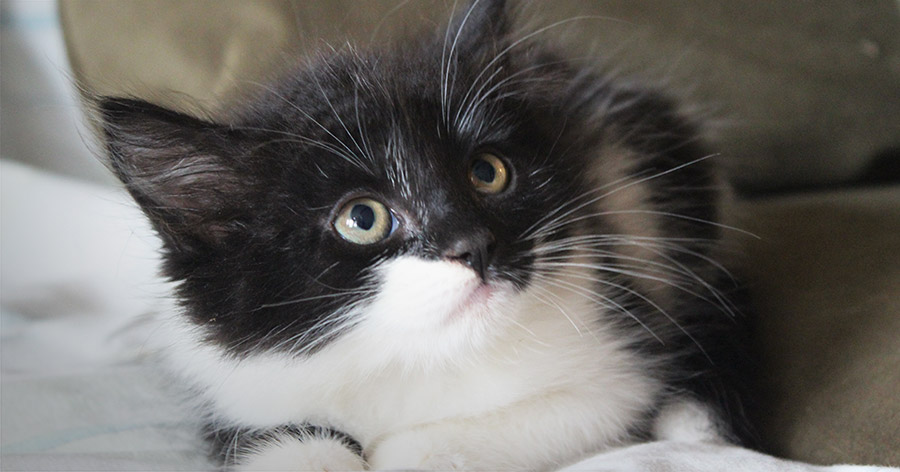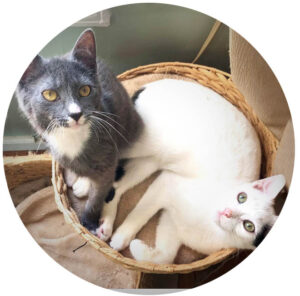Stress and Behavioral Changes in Cats

Common environmental causes of stress and behavior change in cats include moving to a new home, the addition or loss of a human or animal family member, loud parties, and a change in routine such as a new job that results in less quality time with your cat.
If you can’t pinpoint an environmental cause, remember that cats have distinct personalities just like us. It is normal for some cats to be more sensitive and need more love and attention than others, especially rescue cats who have likely endured hardship and abuse.
The following are some recommendations for reducing stress in your cat.
Learn about:
General Tips
1. The best tool is always prevention – be sure to introduce any changes in your cat’s life slowly, monitor their reaction, and provide plenty of loving care to help them feel safe.
2. Feliway plug-in releases a calming pheromone that only cats can smell. Plug these in low along the wall where cats can easily smell them. The cheapest retailer we know of is EntirelyPets.com.
Litterbox Issues
1. Make sure your litterbox is big enough for your cat, in a place the cat can comfortably reach, and is cleaned daily. If your litterbox has a lid, try removing it.
2. Cat Attract is a cat litter that attracts cats to use the litterbox. This is especially useful when first potty training. If you switch litters at any time it is important to transition slowly.
3. It is very important to completely remove the urine smell from the marked area so that the cat will not urinate there again. There are a variety of products designed to remove pet odors. Nature’s Miracle has an extensive product line for this – BAA staffers love it! Check out their site here. In addition, Urine Off is an enzyme cleaner that removes urine from surfaces, and Zero Odor is another similar product. You can also purchase a blacklight to see hidden areas where your cat has marked.
Note: Do NOT use perfumed deodorizers such as Febreze – these often encourage marking where sprayed!
4. To get rid of the smell of cat urine in fabric, wash the fabric twice, not once, or your cat will continue to “mark” the fabric. For example, if your cat urinated on your bed, be sure to wash the sheets twice, and spray Urine Off on the mattress.
Problems with Eating
1. It is common for cats from the street to have food anxiety and aggression; they are used to starving and don’t realize yet that food is going to keep coming. In addition to wet food, try leaving out a reasonable amount of dry food to instill food security in your cat. If your cat needs to lose weight, consult with your veterinarian to determine an appropriate amount of food.
2. If you have multiple cats and one is eating another’s food, the easiest solution is to simply separate them while feeding.
3. Should you change your cat’s diet it is helpful to transition slowly unless otherwise advised by your veterinarian.
Declawing: What You Should Know
Declawing is now banned in New York state.
“By banning this archaic practice, we will ensure that animals are no longer subjected to these inhumane and unnecessary procedures.”
– Governor Cuomo
Read more about this historic legislation.
BAA has always taken a strong stance against declawing. Some people think this harmful procedure is like cutting our fingernails. This is far from the truth. Declawing traditionally involves the amputation of the last bone of each toe on a cat – the equivalent of cutting off each of our fingers at the last knuckle.
The reasons for people declawing a cat vary from discouraging unwanted scratching to preventing infections in those with immune deficiencies. However, scratching can easily be prevented by providing a cat with scratching posts, and the risk of infection from cat scratches is less than that from bites, cat litter, or fleas.
In addition, declawing can itself cause a host of behavioral problems in cats, including being less likely to use the litter box and more likely to bite.
We recommend reading the ASPCA’s statement on declawing and this Humane Society of the United States article on declawing.
If you are experiencing a cat who is scratching furniture, we recommend placing scratching posts near problem areas. You can further discourage scratching by placing cat scratch protection tape on furniture. You may also find that trimming your cats nails is beneficial. Read more on this subject on the ASPCA website.
Additional Resources
Here are a some more useful resources with info on anxiety in cats, including possible causes and solutions:
About.com guide to stress in cats
ASPCA tips for litterbox issues and urine marking
Animal Humane Society guide to introducing a new/second cat to your home


